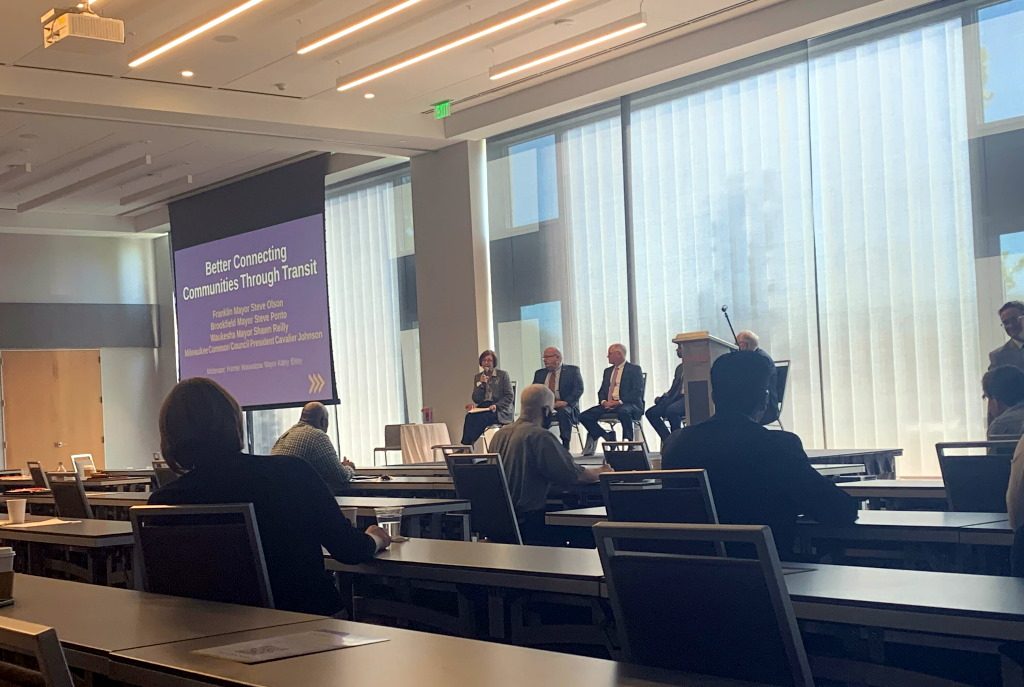Conference In Brookfield Seeks Transit Solutions
Mayor says residents fear buses bring crime, but that it isn't true.
The Regional Transit Leadership Council held a conference Tuesday focusing on Southeast Wisconsin’s workforce shortage and how to provide better transportation options for workers.
The conference was titled “Moving Forward: Multimodal Transportation for a Strong Region” and was held at the Brookfield Conference Center, some 12 miles from downtown Milwaukee.
During the conference, Dave Steele, executive director of Regional Transit Leadership Council (RTLC), announced that the group will be rebranding to Mobilise in October. The organization decided its name was clunky, Steele said.
RTLC is an organization that strives to reimagine regional transit to activate the workforce. It is a successor to Transit Now, which was long led by Kerry Thomas. Steele became executive director in 2018.
The conference began with a welcome by Steele and Paul Decker, chairman for the Waukesha County Board of Supervisors.
Steele emphasized the RTLC’s goals, especially the idea of breaking down “silos” — the tendency of municipalities or counties in a region to act separately from one another and often against one another.
Steele then addressed some major successes the region has seen, particularly with the Bus Rapid Transit project. Service is expected to begin in Fall 2022 and will run nine miles from downtown Milwaukee and on to Marquette University, Milwaukee’s West Side, Wauwatosa and the Milwaukee Regional Medical Center.
Decker discussed the challenges in solving transportation problem in the region. He said many people are very hesitant to change and do not want to break down silos.
He said the current bus system is not efficient. Many of the structures in place, he said, are not suitable for the reality of Wisconsin’s climate. “We design things in this state as if every day is a beautiful September day, like January never happens,” Decker said. He said forcing riders to sit in the cold is inconvenient and unfair.
Decker noted that the average commute from Milwaukee to Waukesha is more than an hour, which he said is not productive time.
Following the welcome, the program featured Missy Hughes, secretary and CEO for Wisconsin Economic Development Corporation, as a keynote speaker.
Hughes said the limited workforce means that it is important to invest in public transportation and multimodal options to improve quality of life. She noted that when companies are trying to figure out a location, they are looking at several quality-of-life issues, including access to transportation.
“As we move toward recovery and think about what we need to invest in … we need to continue to invest in broadband, education and in healthcare. These are the things that will get people back to work,” Hughes said.
Following Hughes’ speech, a panel was held with the mayors of Brookfield, Franklin and Waukesha and Cavalier Johnson, president of the Milwaukee Common Council. The panel was moderated by former mayor of Wauwatosa Kathy Ehley.
Brookfield Mayor Steve Ponto began the discussion of transportation with the issue of entry-level positions in his area. Many people entering those positions do not own an automobile, yet the current bus system is lacking. He talked about the “last mile” problem, where buses routes end far from a corporation and riders have to then walk the rest of the way.
Franklin Mayor Steve Olson discussed its business park and the issues with getting employees there. Waukesha Mayor Shawn Reilly also mentioned the demographics issue, where many people are aging out of jobs, leading to a need for more workers.
All three mayors also discussed the fact that many residents are resistant to bringing bus systems further into the suburbs. Many think a bus means crime will be brought in, when that is not the case, Olson said. He said many bus stops are in retail areas, where crime could occur. However, he said current plans and hopes are to bring buses to more industrial locations where people are working.
The conference concluded with a discussion of solutions for better transit. Tom Winter of MCTS discussed the BRT project and the advancements MCTS has made in terms of technology.
Kelzye Redwell of Horizons in Cedar Rapids, IA, discussed the Neighborhood Transportation Service, a curb-to-curb van service that aims to connect residents to jobs in an area that often did not get cab service. Orlando Owens of The Joseph Project discussed how his organization similarly works to connect workers to jobs in Sheboygan.
He and Redwell both emphasized that nonprofits and organizations outside of the government can help with the transportation issue, saying it is not limited to a public problem.
The conference ended with a concluding remarks by Steele, who discussed the future of Regional Transit Leadership Council.
Urban Milwaukee president Jeramey Jannene serves on the board of the Regional Transit Leadership Council
If you think stories like this are important, become a member of Urban Milwaukee and help support real, independent journalism. Plus you get some cool added benefits.
Political Contributions Tracker
Displaying political contributions between people mentioned in this story. Learn more.
- April 22, 2019 - Cavalier Johnson received $50 from Lafayette Crump
Transportation
-
MCTS Adds 28 New Buses
 Jul 13th, 2024 by Graham Kilmer
Jul 13th, 2024 by Graham Kilmer
-
MCTS Designing New Bus Shelters
 Jul 10th, 2024 by Graham Kilmer
Jul 10th, 2024 by Graham Kilmer
-
MCTS Updates RNC Bus Detours To Better Serve Downtown, Riders
 Jul 9th, 2024 by Jeramey Jannene
Jul 9th, 2024 by Jeramey Jannene























The sub headline is technicality accurate but misleading, and not the major thrust of the conference or the mayors’ assertions. (TBH, it seems a bit click-batey for MKE readers.)
The DNC, potential new businesses and other organizations are going to see our inability to cooperate and decide to go elsewhere. We look provincial. Not only are we inhibiting the acquisition of future talent, we are wasting our existing talent.
Seeking regional transportation requires not just recognizing the need for cooperation, but embracing a keen understanding of how different urban and suburban geographies of our region interact and how current and potential transportation modes can serve our communities better.
This cooperation requires a willingness to see differing perspectives. Land use policies are intertwined with transportation uses. Different population densities support different transportation modes. Transit systems throughout the world operate in climates equal to or harsher than ours. Policies covering everything from zoning to housing to parking play a role in how people choose among transportation options. Urban fabrics for walking and transit developed in our region’s history but were largely erased by an automobile fabric that demanded car dependency. These are the central complicating factors of a cohesive transportation approach that we seek today.
Cooperation involves establishing a permanent, reliable planning and funding framework for transit. The nature of public infrastructure must be recognized as a motivator for community benefits, both public and private. Public transportation is too often criticized for not “making money” when its goal is to build an infrastructure upon which communities and the private sector can flourish. The role of transit in private sector prosperity is often downplayed.
Amazon chose its headquarters expansion site in the Washington, DC area, in part, for the transportation connectivity among rail, bus, air, active, and multimodal transit. The area is known as “National Landing” and blends everything from walkability to transit connections among its unique communities and settings. Our region has the potential for this kind of connectivity and cooperation. However, the rhetoric of denigrating public transit and users is unhelpful for cooperation. The encouragement of a suburban versus urban standoff is counterproductive. Multimodal transportation itself demands cooperation among diverse communities and needs. Transportation should seek to improve the health, equity, livability, and prosperity of all of our communities.
The logic is astonishing: so someone gets off the bus, which has cameras, heads to a store to rob it or goes to mug someone…and then what? They go back and wait for the bus after committing the crime? What a dastardly scheme! Moriarty himself could never have conceived of a crime so flawless! There’s not a detective in the world who could crack that case!
We all know what they mean by “crime will be brought in”. Just swap “crime” with “Black people” and you have a far-more accurate picture of what these residents are worried about.
As the French are fond of saying: “Plus ça change, plus que la meme chose” (The more things change, the more they stay the same).
I started attending these regional transportation conferences decades ago and subsequently stopped wasting my time. There’s no genuine interest in this other than occasionally proposing something akin to the infamous “Apartheid trains” in South Africa to bring in city workers when needed and shuffle them back to where they came from at sundown.
Creation of good paying jobs where the public transportation infrastructure exists (city and close-in suburbs) should be the goal. It’s not easily accomplished to be sure, but continuing to bang our heads into the virtual brick wall separating job seekers from suburban/exurban jobs is getting us nowhere.
I’m reminded of the satirical headline from “The Onion”: “Most Americans Support Public Transportation – For Others”.
Seems to me that the lead picture says quite a bit about the interest in the subject. A lot of empty seats there…
It’s going to be tough to get a response on public transportation with interest levels that appear extremely low. Where is the interest from the private sector? How many businesses were represented at this conference?
Racist Republicans already have their transit solution… I see “temporary employment agency” buses traveling back and forth from Milwaukee to Waukesha all the time on I-94…
P.S. Can’t understand why African Americans and Native Americans haven’t received a single penny in reparations for the 400-500 years of genocide committed against them by the American government yet we spend trillions of dollars every year fighting wars and killing millions of women and children in the Middle East for Israel.
With Amazon, Uline, and all of the other huge warehouse/fufllment centers along I-94 in Oak Creek, Racine and Kenosha County, you would think the the huge corporations who need workers would be proposing some tri-county public transportation system that would make it easier for workers to get to work. A system could use busses that run on a schedule that would be convenient for the workforce. This has not happened and probably won’t. It could stimulate economic development in this corridor along with dealing with a labor shortage. Republicans do not like public transportation even when it makes economic sense.
Companies take subsidized properties in areas that can’t economically be served by even basic public transportation, try hiring workers for wages too low to afford a car, then complain they can’t find any workers.
I don’t think we should be giving them even more handouts. If they want people to drive 15 miles to work pay them appropriately. If they want access to the large talent pool in Milwaukee they can build on the many vacant lots in those areas or work to develop other transit friendly areas.
In a sane world, no large regional employment center (like a factory or an Amazon warehouse) would be built in a transit desert, just as none is ever built where there’s no water or electricity.
Sometimes developers have to shell out for road improvements (like new traffic signals or extra lanes) to handle increased traffic generated by their development. Maybe those same developers should also shoulder the cost of providing transit for those far-flung things out in the middle of nowhere. If that would happen, they would build on bus lines.